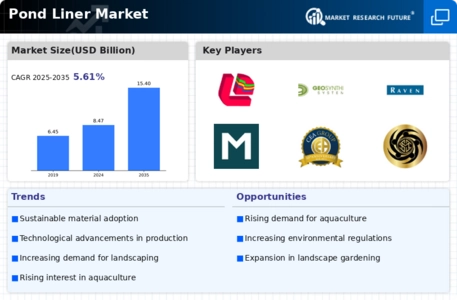Market Growth Projections
The Global Pond Liner Market Industry is poised for substantial growth, with projections indicating a market size of 8.47 USD Billion in 2024 and an anticipated increase to 15.4 USD Billion by 2035. This growth trajectory suggests a robust compound annual growth rate (CAGR) of 5.61% from 2025 to 2035. Factors contributing to this growth include rising demand for water conservation, advancements in liner technology, and the expansion of aquaculture practices. As the market evolves, it is likely to attract new players and innovations, further enhancing its dynamics and competitive landscape.
Expansion of Aquaculture Practices
The Global Pond Liner Market Industry is significantly influenced by the expansion of aquaculture practices worldwide. As the demand for fish and seafood continues to rise, aquaculture operations increasingly rely on pond liners to create controlled environments that enhance fish growth and health. These liners help maintain water quality and prevent contamination, which is crucial for sustainable aquaculture. The industry is witnessing a shift towards more intensive aquaculture systems, where pond liners play a vital role in ensuring optimal conditions. This trend not only supports the growth of the Global Pond Liner Market but also aligns with the broader objectives of food security and sustainable resource management.
Rising Demand for Water Conservation
The Global Pond Liner Market Industry experiences a notable increase in demand driven by the growing emphasis on water conservation. As water scarcity becomes a pressing global issue, pond liners are increasingly utilized in agricultural and landscaping applications to minimize evaporation and optimize water usage. This trend is particularly evident in regions facing severe drought conditions, where pond liners serve as an effective solution to retain water. The market is projected to reach 8.47 USD Billion in 2024, reflecting the heightened awareness of sustainable practices. This demand for efficient water management solutions is likely to propel the market forward, contributing to a projected CAGR of 5.61% from 2025 to 2035.
Growth of Landscaping and Garden Design
The Global Pond Liner Market Industry is experiencing growth fueled by the rising popularity of landscaping and garden design. Homeowners and commercial property developers are increasingly incorporating water features into their designs, leading to a surge in demand for pond liners. These liners not only enhance aesthetic appeal but also provide functional benefits, such as water retention and habitat creation for wildlife. The trend towards outdoor living spaces is likely to continue, further driving the need for pond liners in various landscaping projects. This growing interest in garden design and landscaping contributes to the overall expansion of the Global Pond Liner Market, reflecting changing consumer preferences.
Technological Advancements in Liner Materials
Technological advancements in liner materials are reshaping the Global Pond Liner Market Industry. Innovations in polymer technology have led to the development of more durable, UV-resistant, and environmentally friendly liners. These advancements enhance the performance and longevity of pond liners, making them more appealing to consumers. For instance, the introduction of reinforced polyethylene liners has improved resistance to punctures and tears, thereby reducing maintenance costs. As these technologies continue to evolve, they are expected to drive market growth, with the industry projected to reach 15.4 USD Billion by 2035. The adoption of advanced materials aligns with the increasing demand for high-quality and sustainable pond solutions.
Regulatory Support for Environmental Sustainability
Regulatory support for environmental sustainability is a key driver of the Global Pond Liner Market Industry. Governments worldwide are implementing policies and regulations aimed at promoting sustainable water management practices. These initiatives often encourage the use of pond liners in agricultural and recreational applications to reduce water loss and enhance ecosystem health. For example, subsidies and incentives for sustainable farming practices may include the adoption of pond liners as a means to conserve water resources. This regulatory environment not only fosters market growth but also aligns with global efforts to address climate change and promote sustainable development.

















Leave a Comment